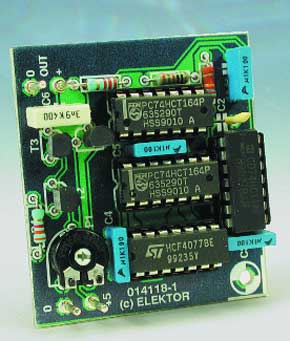Article
Noise Generator

The noise generator proposed here operates according to the digital principle, in contrast with the more classical noise generator, which usually employs the noise voltage of a base/emitter junction to generate the signal. The big difference between the method used here and the classical analogue design is that we are not generating a real noise voltage but a collection of discrete frequencies.
Materials
Gerber file
CAM/CAD data for the PCB referred to in this article is available as a Gerber file. Elektor GREEN and GOLD members can exclusively download these files for free as part of their membership. Gerber files allow a PCB to be produced on an appropriate device available locally, or through an online PCB manufacturing service.
Elektor recommends the Elektor PCB Service service from its business partner Eurocircuits or AISLER as the best services for its own prototypes and volume production.
The use of our Gerber files is provided under a modified Creative Commons license. Creative Commons offers authors, scientists, educators and other creatives the freedom to handle their copyright in a more free way without losing their ownership.
PCB
Component list
Resistors:
R2 = 56k?
R3 = 2k?2
R4 = 3k?3
P1 = 5k? preset
Capacitors:
C1,C3,C4,C5 = 100nF
C2 = 820pF
C6 = 3nF9
Semiconductors:
T1,T2 = BC547
T3 = BC557
IC1 = 74HCT14
IC2,IC3 = 74HCT164
IC4 = 4077
R2 = 56k?
R3 = 2k?2
R4 = 3k?3
P1 = 5k? preset
Capacitors:
C1,C3,C4,C5 = 100nF
C2 = 820pF
C6 = 3nF9
Semiconductors:
T1,T2 = BC547
T3 = BC557
IC1 = 74HCT14
IC2,IC3 = 74HCT164
IC4 = 4077


Discussion (0 comments)